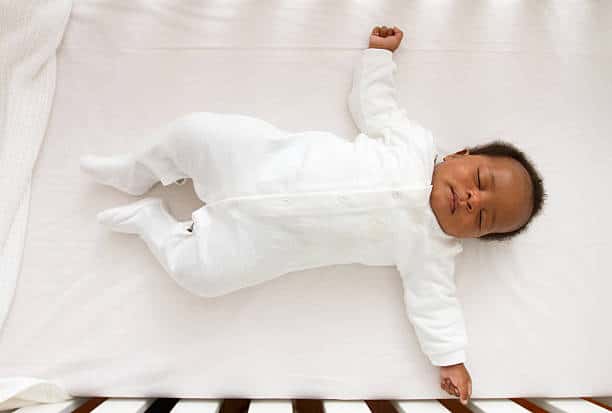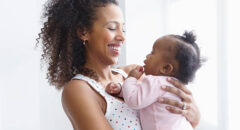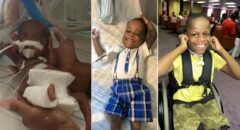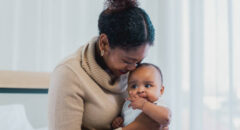
Sudden Unexpected Infant Death (SUID), which are sleep-related deaths due to suffocation as well as those formerly known as Sudden Infant Death Syndrome (SIDS), is defined as the death of an infant less than 1 year of age without other obvious causes. SUID kills one baby nearly every week in Cook County, IL. In our county, SUID occurs 15 times more often in Black babies, and nearly 3 times more often in Hispanic babies, than in White babies. The rate of SUID for preterm Black infants in Cook County is 472 per 100,000 preterm births – or 1 in 212 preterm Black births. Though these deaths are largely preventable by practicing safe sleep, according to the American Academy of Pediatrics, safe sleep guidelines are often not followed because awareness of how often SUID occurs remains low among parents, communities, and those in healthcare. Awareness remains low for a number of reasons – these deaths never make the news, are difficult to talk about, and have long been considered tragedies that “just happen” – all of which limit hope and trust in prevention.
The American Academy of (AAP) is the largest, leading organization of pediatricians and providers making recommendations for practices that impact the health, safety, and well-being of children. The recommendations of the AAP to reduce the rate of SUID deaths help parents and caregivers remain hopeful that there are steps that can be taken to reduce suffocation risk and death during infant sleep.
The cornerstone of preventing SUID is known as the “ABCs” of safe sleep and includes having babies sleep Alone, on their Backs, in their Cribs.
A- Babies should sleep alone.
Babies should sleep alone in their cribs, but close enough that someone can hear and respond to them quickly, or room-sharing. Room-sharing protects infants from SUID, is widely encouraged and practiced in many hospitals following delivery.
Myth: It is safer for me to sleep with my baby so I can quickly respond to them.
Truth: Unsafe sleep factors such as sleeping with another person have been found to increase the risk of infant death by suffocation. Suffocation happens when a parent or sibling accidentally lays over the infant; when an infant rolls and smothers in soft bedding; or becomes wedged between the bed and wall, making it impossible for them to breathe. This risk is higher for babies who are premature, or who have parents that are under the influence of any sedating substance such as prescription medications, alcohol or other drugs.
RELATED: SIDS Awareness: 5 Things You Can Do To Protect Your Child
B- is for backs.
Babies should be placed on their backs for every sleep and nap.
Myth: If my baby spits up on while asleep on his back he will choke.
Truth: If babies sleeping on their backs spit up, the food coming from the stomach to the throat (esophagus) must work against gravity to get into their windpipe (trachea). However, if they are sleeping on their tummies, it is much easier for spit up to travel from their stomach and go into their windpipe, causing fluid to enter into their lungs, which is also known as aspiration.
Myth: If my baby sleeps on his back, he will develop a flat head.
Truth: When supervised and awake babies should be placed on their tummy to help prevent flat spots and to develop the muscles needed to lift their heads.
Myth: Side sleeping is safe for my baby.
Truth: Babies are strong, but they are not yet coordinated. They may roll from their side to their stomach, but not be able to roll away from an unsafe situation. If they roll from their side into their parent, a pillow, or the mattress, they may not be able to roll themselves back, and can suffocate.
C- is for cribs.
Babies should sleep on a flat (not inclined), firm sleep surface. Safety-approved cribs and bassinets meet this standard. Cribs should have firm mattresses with a fitted sheet and should be free of soft bedding. Soft bedding - including pillows, comforters, quilts, sheepskins, blankets, bumper pads, plush toys or stuffed animals - has been shown to increase the risk of death by suffocation. Sleep sacks or wearable blankets are recommended for infant sleep and can keep your baby warm while keeping their sleep space free of loose bedding which they can become tangled in during sleep increasing their risk of suffocation. Wearable blankets should not be weighted – weights in baby blankets can make it harder for a baby’s chest wall to move easily while breathing.
Myth: It is okay for my baby to sleep in a swing, sling, or car seat.
Truth: The AAP recommends that babies sleep on a firm, flat (not inclined) surface. All inclined sleepers have been recalled and manufacturers are prohibited from developing inclined infant sleep products following the deaths of hundreds of infants in such products. The Consumer Product Safety Commission (CPSC) regulates the use of infant products. Please do not place your baby to sleep in any product that does not meet these federal safety requirements.
Lastly, babies who are fed breastmilk (whether by bottle or breast), and those who use a pacifier (once successful breastmilk production has been established), have been found to have a decreased risk of sleep-related deaths. The AAP recommends that babies be fed only breastmilk in the first six months of life and that breastmilk feedings continue up to two years of life, if desired. The use of breastmilk feeding is “dose-dependent” in reducing SUID, meaning the longer breastmilk is given, particularly when it is the only milk provided, the greater the protection it provides from SUID. Any amount of breastmilk is better than none at all.
We must be clear. The “Back to Sleep” campaign in 1994 successfully reduced SIDS deaths by 44%. However, following this initial success, there has been little further progress in substantially reducing these deaths. We have known the protective effects of the ABCs of breastfeeding, maintaining healthy pregnancies and a smoke-free environment for more than 20 years, however, the number of SUIDs in the US remains at ~3,400 deaths every year, and disparities in SUIDs have increased. We must examine and improve our approach to listening to families and communities most impacted by SUID, raising awareness alongside those supporting pregnant and parenting families, and educating those in healthcare in modeling safe infant sleep in birth hospitals and promoting respectful conversations to prevent SUID. It will take all of us – everyone who supports a family with a new baby – to do our part to reduce the rates of SUID.
Written by Dr. Christie Lawrence & Dr. Gina Lowell









